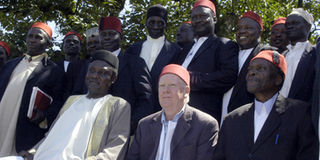Monarch fights to keep his kingdom alive

US Ambassador Michael Ranneberger (centre) and Prince Peter Mumia II (seated far left) with other Wanga elders soon after he was installed as a wanga elder at the Nabongo Mumia cultural centre in Matungu recently. Photo/JACOB OWITI
To many Kenyans, the Wanga Kingdom is a defunct entity only remembered in history books and tales of the legendary Nabongo Mumia. The fact that the kingdom is alive and well came to the limelight last week when the omnipresent American ambassador Michael Ranneberger was installed as an elder of the Wanga Kingdom last Wednesday.
At the Nabongo Mumia Cultural centre in Matungu constituency, Mr Ranneberger looked a little bewildered as instantly-composed praise songs were belted out in his honour, complete with baptism that came with a new name, Shiundu. The ambassador acknowledged the rich culture of the Wanga, which he described as “the only ancient kingdom in Kenya”.
“He is beyond being made a warrior, so we made him an elder,” explained the claimant to the throne, “His Highness” Prince Peter Mumia II. Mumia II presides with the help of a Council of Elders, but the Kingdom and its titles and organs are largely non-existent, having no official recognition and no authority except maybe over a few cultural issues.
The elders work through five committees that carry out different tasks. These include advisory, historical, cultural affairs, information and publicity, and investment. The “monarch” is free to name whoever he pleases to the council of elders.
The association with Mr Ranneberger provides a welcome fillip for an institution crying out for attention. And maybe a little more because at the function last week, there was a plea for financial assistance. The Kingdom required some Sh146 million for a multi-purpose hall and guest wing, amongst other improvements on the cultural centre.
In his brief State of the Kingdom speech, the Mumia II said that though the region had a huge untapped potential in natural resources and manpower, it was mired in poverty. “We only need a little push and the rest will be done,” he said, adding that the region was once the granary of Western Kenya.
“I will take the requests seriously and look into what we can do even though we have a difficult budget situation I will make an honest approach to do something instead of making false promises,” Mr Ranneberger responded. He was shown the regalia donned by the Kingdom’s leaders of yore.
The journey into the culture of the Wanga Kingdom would not be complete without a visit to the mausoleum where the remains of the past kings Nabongo Wanga, Nabongo Mumia I and Nabongo Netia, were buried. The current Wanga monarch has been relegated to performing traditional ceremonies such as weddings and funerals.
If he ever gets officially coronated, he would become the 28th ruler in the history of the kingdom. But he may have a long wait, for unlike in neighbouring Uganda, there are no plans to revive the traditional kingdoms. According to Prince Mumia, the Kingdom dates back to 1050AD with the birth of Nabongo Wanga to King Mwanga III.
He would be exiled from Uganda to settle in Lela, Nyanza Province, and eventually Imanga, in what came to be Mumias District, where he was taken in by area chief Mumia as a herdsman. His stay was short-lived, as he was kicked out when the chief’s wife saw him with a rare ring (omukasa), which meant he was royalty. He settled in a nearby village and ousted the chief. He later moved to Matungu around 1100AD and died in 1140AD.
Successful leader
Nabongo Mumia I went down in history as the most successful leader of the kingdom. Born in 1849, he succeeded his father Nabongo Shiundu in 1880. “He was a brave, shrewd and intelligent king and ruled with supreme authority,” says Mumia II. He was the King, Chief Justice, Commander-in-Chief and final appeal authority at all civil and criminal cases in the vast kingdom “traversing Western region to Naivasha and all the way to Jinja, Uganda.”
The Nabongo also had chiefs representing him from among other communities, with Chief Chabasinga taking care of Busoga Jinja; Chief Lenana Talai the Maasai and Chief Odera Akang’o in charge of the Luo. ‘‘Mumia I became so popular that whites like Joseph Thompson and Bishop Hannington visited between 1883 and 1889 and sought his guidance through to Uganda,” says Mumia II.
Bishop Hannington, who was killed in Uganda days after meeting Nabongo Mumia I, was buried in Mumias, with his grave now at the periphery of a football pitch.




